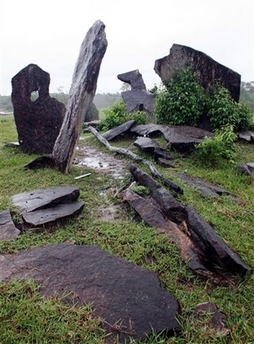
Granite
blocks are seen in Amapa, Brazil, on May 10, 2006. A grouping of 127
granite blocks along a grassy Amazon hilltop may be the vestiges of South
America's oldest astronomical observatory, according to archeologists who
say the find challenges long-held assumptions about the region's
prehistory. [AP Photo] |
A grouping of granite
blocks along a grassy Amazon hilltop may be the vestiges of a centuries-old
astronomical observatory, a find archaeologists say indicates early rainforest
inhabitants were more sophisticated than previously believed.
The 127 blocks, some as high as 9 feet tall, are spaced at regular intervals
around the hill, like a crown 100 feet in diameter.
On the shortest day of the year, Dec. 21, the shadow of one of the blocks
disappears when the sun is directly above it.
"It is this block's alignment with the winter solstice that leads us to
believe the site was once an astronomical observatory," said Mariana Petry
Cabral, an archaeologist at the Amapa State Scientific and Technical Research
Institute. "We may be also looking at the remnants of a sophisticated culture."
Anthropologists have long known that local indigenous populations were acute
observers of the stars and sun. But the discovery of a physical structure that
appears to incorporate this knowledge suggests pre-Columbian Indians in the
Amazon rainforest may have been more sophisticated than previously suspected.
"Transforming this kind of knowledge into a monument; the transformation of
something ephemeral into something concrete, could indicate the existence of a
larger population and of a more complex social organization," Cabral said.
Cabral has been studying the site, near the village of Calcoene, just north
of the equator in Amapa state in far northern Brazil, since last year. She
believes it was once inhabited by the ancestors of the Palikur Indians, and
while the blocks have not yet been submitted to carbon dating, she says pottery
shards near the site indicate they are pre-Columbian and maybe older, as much as
2,000 years old.
Last month, archaeologists working on a hillside north of Lima, Peru,
announced the discovery of the oldest astronomical observatory in the Western
Hemisphere, giant stone carvings, apparently 4,200 years old, that align with
sunrise and sunset on Dec. 21.
While the Incas, Mayans and Aztecs built large cities and huge rock
structures, pre-Columbian Amazon societies built smaller settlements of wood and
clay that quickly deteriorated in the hot, humid Amazon climate, disappearing
centuries ago, archaeologists say.
Farmers and fishermen in the region around the Amazon site have long known
about it, and the local press has dubbed it the "tropical Stonehenge."
Archeologists got involved last year after geographers and geologists did a
socio-economic survey of the area, by foot and helicopter, and noticed "the
unique circular structure on top of the hill," Cabral said.
Scientists not involved in the discovery said it could prove valuable to
understanding pre-Columbian societies in the Amazon.
"No one has ever described something like this before. This is an extremely
novel find, a one of a kind type of thing," said Michael Heckenberger of the
University of Florida's Department of Anthropology.
He said that while carbon dating and further excavation must be carried out,
the find adds to a growing body of thought among archaeologists that prehistory
in the Amazon region was more varied than had been believed.
"Given that astronomical objects, stars, constellations etc., have a major
importance in much of Amazonian mythology and cosmology, it does not in any way
surprise me that such an observatory exists," said Richard Callaghan, a
professor of geography, anthropology and archaeology at the University of
Calgary.
Brazilian archaeologists will return in August, when the rainy season ends,
to carry out carbon dating and further excavations.
"The traditional image is that some time thousands of years ago small groups
of tropical forest horticulturists arrived in the area and they never changed,
(that) what we see today is just like it was 3,000 years ago," Heckenberger
said. "This is one more thing that suggests that through the past thousands of
years, societies have changed quite a lot."